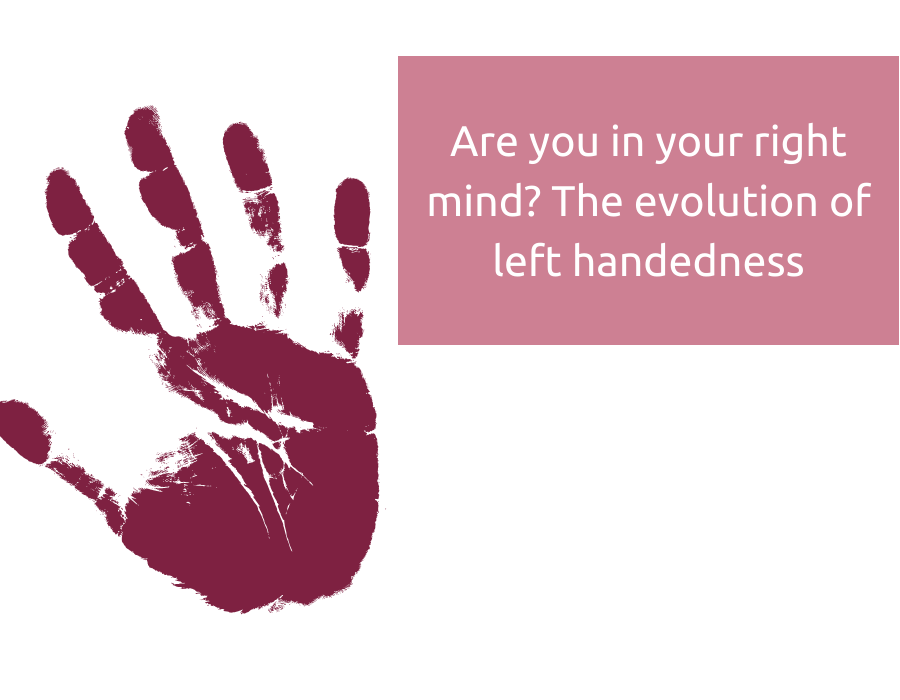Roisin Conneely
This week, the world (well, 10% of it) celebrated Left Handers Day, an international awareness day set up to celebrate the small population of humans who predominantly use their left hands for tasks, and to recognise the struggles they face every day. Being a leftie, I am all too aware of these challenges, from scissors, spiral notebooks, constantly smudging my writing, right-handed lecture desks, can openers…the list goes on! So we thought we’d take a look at the reasons why some people are left handed, and what it means to be a “southpaw”.
 To first understand our left and right hands, we must first look at the left and right sides of the human brain. Whilst from the surface, the brain may appear to be equally proportioned, it actually comprises an asymmetrical structure, which is crucial in defining the functions it carries out. The brain is divided into two hemispheres; left and right, each varying slightly in size and specialised regions, which means that each hemisphere is adapted to perform specific actions. Given that many other mammals have largely symmetrical brains, why is it that humans have evolved to have two brain hemispheres? Numerous studies have examined the differences in the two hemispheres of the brain, and it may be argued that this asymmetrical structure has had an evolutionary influence on the level of cerebral functions humans are able to process, being so different to many other animals which are not as intellectually or socially developed as we are.
To first understand our left and right hands, we must first look at the left and right sides of the human brain. Whilst from the surface, the brain may appear to be equally proportioned, it actually comprises an asymmetrical structure, which is crucial in defining the functions it carries out. The brain is divided into two hemispheres; left and right, each varying slightly in size and specialised regions, which means that each hemisphere is adapted to perform specific actions. Given that many other mammals have largely symmetrical brains, why is it that humans have evolved to have two brain hemispheres? Numerous studies have examined the differences in the two hemispheres of the brain, and it may be argued that this asymmetrical structure has had an evolutionary influence on the level of cerebral functions humans are able to process, being so different to many other animals which are not as intellectually or socially developed as we are.
Studies using MRI scans have revealed variances in the two hemispheres of the brain. Images produced can be manipulated to accentuate the deviations from an exact mirror image, leading to a greater understanding of the functional differences between the left and right side. For example, scans have shown that the area of the temporal lobe used for understanding speech is slightly larger on the left side of the brain in comparison to the right. This supports the theory that the capacity for understanding language is largely located in the left side of the brain. Broca’s area is a region located in the frontal lobe of the brain, composed of two major structures; the pars triangularis and the pars opercularis. The pars triangularis, which is positioned towards the front of Broca’s area, is used in interpreting various forms of stimuli, for example, to associate words with particular meanings. The pars opercularis is situated at the posterior of the area, and is involved in unimodal association; the comprehension of a single type of stimulus at a time.
It is also essential in the physical movement of the mouth to produce words. If a person suffers damage to Broca’s area in the left hemisphere, they are often left unable to speak, however, damage to the same area on the right side of the brain does not have the same debilitating effect. This suggests that there is a functional asymmetry in the distribution speech and language comprehension throughout the brain. Because the left side of the brain controls movement on the right side of the body, it stands to reason that the speciality for interpreting and communicating in this hemisphere must also be displayed on the right side. This is seen in the fact that intense feelings of joy and sorrow are more clearly expressed on the right side of the face compared to the left. This would have been a major factor in the evolution of human sociality; combined with the development of language, the ability to understand strong emotions in facial expressions would have helped early humans to bond with each other and form communities, potentially laying the foundations for humans settling and creating early civilisations.
The word “left” is derived from an Old English word; “lyft”, which literally meant “weak”. The Latin word for left “sinistra” also led to the modern “sinister”, with all its negative connotations. Language doesn’t favour the lefties!
Now on to the main issue at hand (get it?!), dominant hand preference. The right side of the brain controls the left side of the body, and vice versa, hence it may be expected that there would be a random, equal distribution of handedness in the human population. However, only around 10% of people are left handed, suggesting that there may be an evolutionary advantage in the brain adapting left hemisphere dominance for hand control and movement. Researchers from Northwestern University, Illinois, have proposed a theory using data from competitive sports, claiming that right hand dominance is linked to the evolution of human sociality. One of the researchers, Daniel M. Abrams, states that;
“The more social the animal, where cooperation is highly valued, the more the general population will trend toward one side. The most important factor for an efficient society is a high degree of cooperation.”
This theory suggests that as humans have evolved to become more social, right handedness has become advantageous, as the majority of the population having the same hand dominance should mean that they are able to cooperate more effectively, for example, by sharing tools. Yet, if human society was entirely cooperative, then we should all be right handed. Natural selection, however, ensures that there will always be left handers, as this trait allows for competition, for instance, in a physical fight, early humans who were left handed may have had an advantage over right handers as they would be able to take them by surprise more easily. This again shows how the brain, with its asymmetry in structures and functions, has been instrumental in allowing humans to evolve in the way we have.
A recent study has suggested that handedness is determined by the spinal cord whilst you’re still a growing embryo. The left side of the spinal cord was found to develop slightly quicker than the right, demonstrating an early asymmetry in neuronal development. The scientists believe that these early left-right asymmetries within the spinal cord may later trigger asymmetries in the brain, leading eventually to hand dominance.
So, what does being left handed actually mean for an individual? For centuries lefties were shunned and believed to be witches, after all, the Devil himself was considered to be a southpaw. But, biologically, we may have a few advantageous traits compared to our right handed counterparts. For example, the corpus callosum, composed of a thick, curved band of white matter which connects the two hemispheres to allow communication between them, is believed to be larger in left handers. This may allow for advanced coordination, multitasking and information processing. However, there are some more “sinister” side effects too. A 1988 study indicated that left handers died younger than their right handed counterparts. However, the methods of this study have been challenged, and a 1994 study of cricketers surmised that left handedness is generally not associated with increased mortality (phew!). Numerous other studies have suggested that left handed people are more likely to suffer from mental disorders, with one study finding that in a population of patients with schizophrenia and schizoaffective disorder, 40% of them were left handed. However, schizophrenia is a complicated disorder, with numerous factors playing a role in its development, so, whilst there may be an association to handedness, it’s far too early to suggest being a leftie causes such illnesses.
It’s clear that the development of two brain hemispheres has allowed humans to designate functions to specialised structures, without having to lose valuable cortical space. This lateralisation of functions means that our brains have adapted specific regions to process things such as language, reading of facial expression, memories, as well as hand dominance, all of which have arguably aided the development of human sociality, without which the human race may never have been able to survive and reproduce as successfully as we have. So, whilst we may be oddities, we lefties are certainly small cases of scientific wonder, and we should celebrate that fact more often!
Sources:
- Carter, Rita (2009) The Brain Book. DK Books
- http://www.rightleftrightwrong.com/brain.html
- Mandal, M.K, Asthana, & H.S, Pandey, R., (1995) Asymmetry in emotional face: its role in intensity of expression. The Journal of Psychology. 129; 235-241 https://www.ncbi.nlm.nih.gov/pubmed/7760297
- Abrams, D.M, & Panaggio, M.J. (2012) A model balancing cooperation and competition can explain our right handed world and the dominance of left handed athletes. Journal of The Royal Society. 9; 2718-2722 http://rsif.royalsocietypublishing.org/content/royinterface/9/75/2718.full.pdf
- 10.1016/j.biopsych.2017.01.016
- http://science.sciencemag.org/content/229/4714/665.long
- http://journals.sagepub.com/doi/pdf/10.1177/2158244013503166





scinergy21
hi, Pals
very well written.
One doubt: is it true that lefties are more logical and analytical?
Seeking Science
Thank you!
Traditionally, there’s the idea that the right side of the brain is the more analytical side, whereas the left is more creative. Seeing as the right side of the brain controls the left side of the body, and vice versa, this has been interpreted to mean that left handed people are generally more creative than logical. However, this idea has been thoroughly debunked; although certain functions may be rooted in one side of the brain, such as spatial awareness for example (right side), there is no such thing as being “left-brained” or “right-brained”. So, it’s a myth that your handedness determines whether you’re more creative or logical! Hope that answers your question!
fonald
Lefties are smarter, that is the main difference. HUGE difference in average I.Q……lol